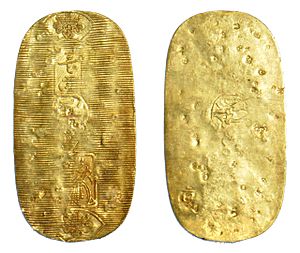Keichō facts for kids
Keichō (慶長) was a special name for a time period in Japan. It came after the Bunroku period and before the Genna period. This era started in October 1596 and ended in July 1615. During this time, the emperors of Japan were error: {{nihongo}}: Japanese or romaji text required (help) and error: {{nihongo}}: Japanese or romaji text required (help).
The name Keichō means "Eternal Jubilance" or "Long-lasting Happiness."
Important Events During Keichō
The Keichō era was a very important time in Japanese history. Many big events happened that shaped the country's future.
The Imjin War (1596)
- 1596 (Keichō 1): Japan was involved in a war with Korea. This conflict is also known as the Imjin War.
The Death of Toyotomi Hideyoshi (1598)
- 18 September 1598 (Keichō 3): Toyotomi Hideyoshi, a powerful leader who had united much of Japan, died at 63 years old. His death led to new power struggles.
The Battle of Sekigahara (1600)
- 21 October 1600 (Keichō 5): The famous Battle of Sekigahara took place. This battle was known as "the battle that determined the future of the country" (天下分け目の合戦, Tenka wake-me no kassen). It was a huge fight that decided who would rule Japan next.
Tokugawa Ieyasu Becomes Shogun (1603)
- 1603 (Keichō 8): After winning the Battle of Sekigahara, Tokugawa Ieyasu was named Shogun. The Shogun was the military ruler of Japan. This marked the beginning of the Edo period, which lasted for over 250 years.
Mapping Japan (1605)
- 1605 (Keichō 10): The government led by the Shogun ordered the first major map of Japan to be made. This was important for understanding and controlling the country.
Ryukyu Kingdom Invasion (1609)
- 1609 (Keichō 12): The Satsuma domain, a powerful region in Japan, invaded the Ryukyu Kingdom. The king of Ryukyu, Shō Nei, traveled to Edo (modern-day Tokyo) to meet the Shogun.
Emperors and Succession (1610-1611)
- 20 May 1610 (Keichō 15): Toyotomi Hideyori, Hideyoshi's son, visited the former-Shogun Tokugawa Ieyasu in Kyoto. On the same day, Emperor Go-Yōzei announced he wanted to step down. He planned for his son Masahito to become the next emperor.
- 9 May 1611 (Keichō 16): Emperor Go-Yōzei officially stepped down. His son took over the role, and soon after, Emperor Go-Mizunoo's position as ruler was confirmed by special ceremonies.
Gifts and Missions (1612-1613)
- 1612 (Keichō 17): The oldest clock in Japan was given to Tokugawa Ieyasu. It was a gift from Philip V of Spain.
- 1613 (Keichō 18): Hasekura Tsunenaga led a special trip to meet leaders in the Americas and Europe. This was an important diplomatic mission.
The Sieges of Osaka (1614-1615)
- 1614 (Keichō 19): The Siege of Osaka began. This was a series of battles between the Tokugawa Shogunate and the supporters of Toyotomi Hideyori.
- 18 October 1614 (Keichō 19): A strong earthquake shook Kyoto during this tense time.
- 1615 (Keichō 20): The Osaka Summer Battle took place. This battle ended the Toyotomi family's power and solidified the Tokugawa Shogunate's rule over Japan.
Related Periods
Images for kids
See also
 In Spanish: Keichō para niños
In Spanish: Keichō para niños

All content from Kiddle encyclopedia articles (including the article images and facts) can be freely used under Attribution-ShareAlike license, unless stated otherwise. Cite this article:
Keichō Facts for Kids. Kiddle Encyclopedia.





